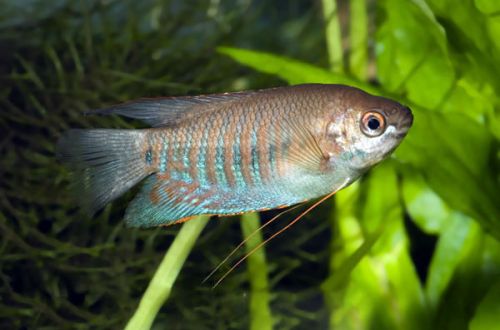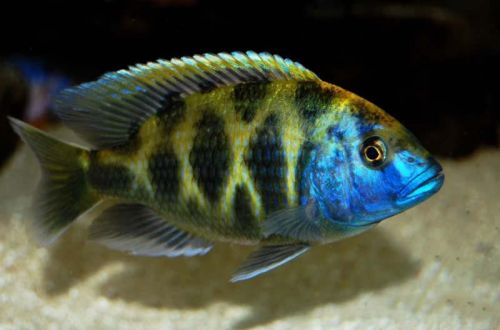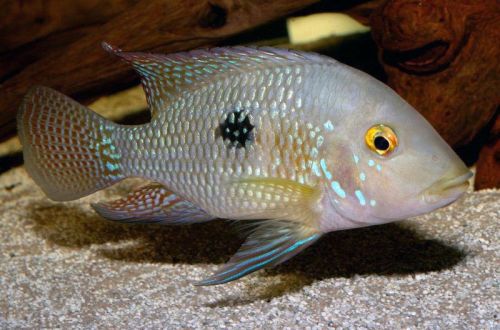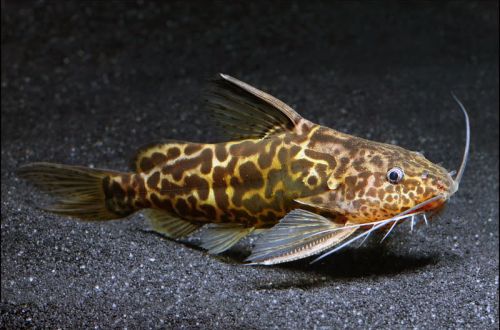
Labiosis
Labiosa, scientific name Trichogaster labiosa, belongs to the Osphronemidae family. Considered one of the most peaceful species among Gourami, the theme is no less inferior in popularity to most of its relatives. It is easy to keep and breed and can be recommended to beginner aquarists.

Contents
Habitat
Comes from South Myanmar (Southeast Asia). Inhabits slow-flowing rivers and streams, as well as lakes and artificial ponds. It is found, as a rule, in places with dense floating vegetation, avoids open water.
Brief information:
- The volume of the aquarium – from 70 liters.
- Temperature – 22-27°C
- Value pH — 6.0–7.5
- Water hardness – soft to medium hard (1-15 dGH)
- Substrate type – any dark
- Lighting – subdued
- Brackish water – no
- Water movement – little or no
- The size of the fish is up to 10 cm.
- Food – any food
- Temperament – peaceful
- Content both singly and in a group
Description
Adult individuals reach a length of about 10 cm. Males are somewhat larger and brighter colored compared to females, in addition, they have pointed dorsal and anal fins. The coloration is dominated by two shades – orange and blue, which alternate in the body pattern from vertical oblique stripes.
Food
Being completely unpretentious to the diet, Labiosa will accept most popular dry, frozen and live foods. The combination of several types of food in the daily diet favorably affects the brightness of the color of the fish.
Maintenance and care, arrangement of the aquarium
Tank sizes for one pair of fish start at 70 liters. The design uses dense clusters of floating shade-loving plants and a dark substrate. The presence of shelters in the form of snags and other decorative objects is welcome.
Optimal housing conditions are achieved with low light levels and gentle filtration that does not create excessive internal flow. The hydrochemical parameters of the water must be within neutral pH values at low or medium hardness (dGH). To avoid accidental jumping out, the aquarium should be equipped with a lid, which also helps to maintain a warm, moist layer of air above the surface, which is important for the respiration of labyrinth fish.
Maintenance comes down to regular cleaning of the soil from organic waste and weekly water changes (10–15% of the volume) with fresh water.
Behavior and Compatibility
It has a peaceful, meek disposition, no intraspecific conflicts have been noticed, it is able to live in large groups. Labiosa is great for the community aquarium and may even look better than the popular Lyalius. Compatible with most other peaceful species. Sharing with a close relative of the Striped Gourami should be avoided to prevent the appearance of hybrid offspring.
Breeding / breeding
Spawning is recommended to be carried out in a separate tank. For these purposes, a small aquarium from 30–40 liters is suitable, filled with water only halfway – an imitation of shallow water, with numerous floating plants. Water conditions should correspond to the general aquarium. The set of equipment consists of a simple airlift filter, a heater and a low power lamp. A lid is a must.
The mating season in the artificial environment begins regardless of the season, so when some fish become noticeably rounder, while others acquire a more saturated color, then it’s time to prepare a spawning aquarium. The female is transplanted first, the male joins after a couple of days and, as a rule, immediately begins to build a nest of bubbles among dense thickets of plants, which can reach 5 cm or more in diameter.
Spawning itself is accompanied by a kind of “embrace”, during which eggs and seeds are released. The fertilized eggs are picked up by the male and transferred to the nest. Further, the female does not take part in caring for the offspring, while the male remains to guard the clutch and fry in the first days of their life, until they begin to swim freely in search of food. This takes about 4-5 days, then it can be returned to the general aquarium.
Fish diseases
The main cause of most diseases is unsuitable living conditions and poor-quality food. If the first symptoms are detected, you should check the water parameters and the presence of high concentrations of hazardous substances (ammonia, nitrites, nitrates, etc.), if necessary, bring the indicators back to normal and only then proceed with treatment. Read more about symptoms and treatments in the Aquarium Fish Diseases section.





